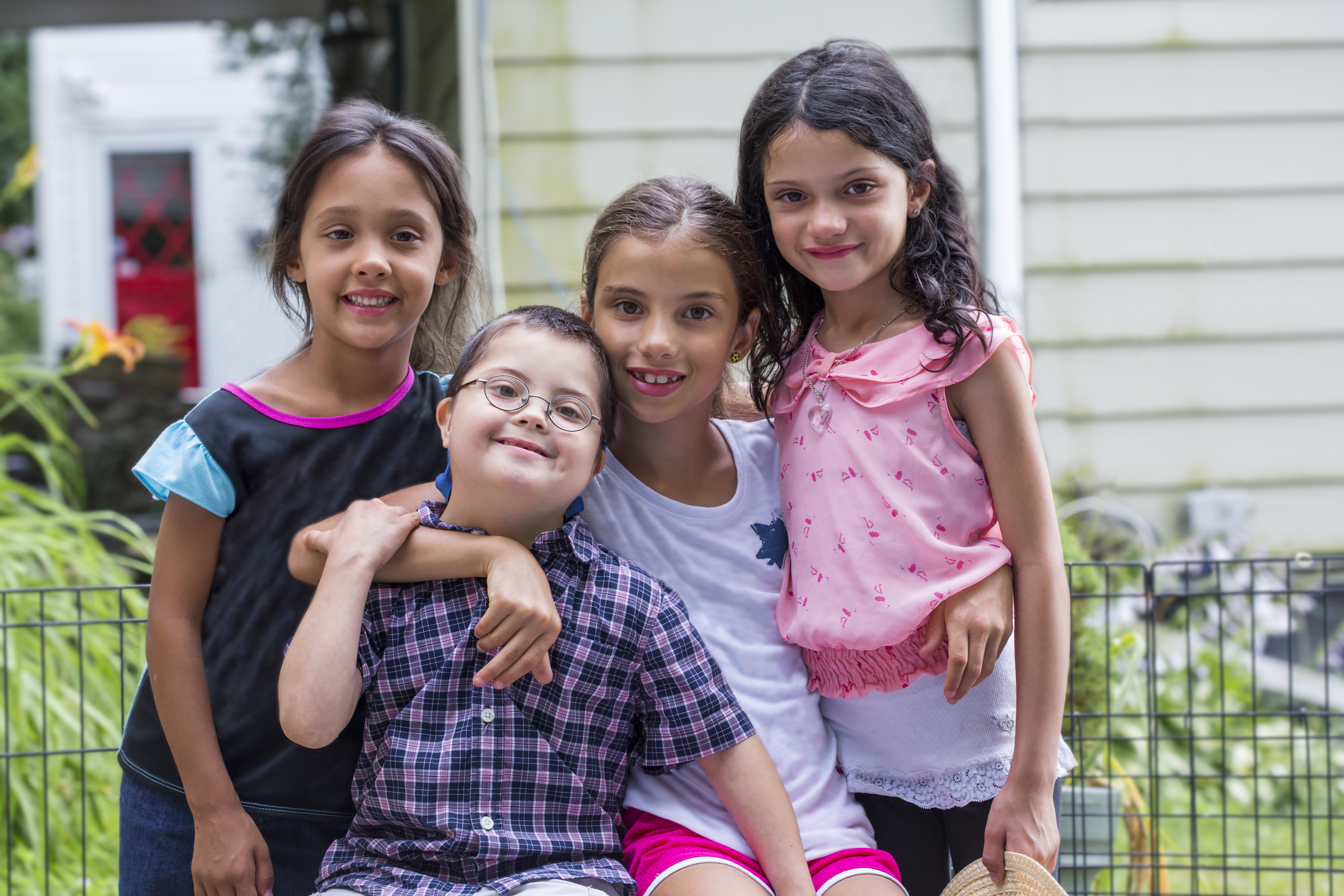Have you ever scrolled through social media and come across a picture or a short video of an animal, perhaps a big cat like a lion or a tiger, with facial features that seem a bit different? Maybe the eyes look a little wider apart, or the nose has a flatter shape. It's almost certain that someone, somewhere, has labeled that creature as having "Down syndrome." This idea, that animals can have Down syndrome, has been floating around the internet for quite some time, so it’s something many people have seen.
These images and clips, especially those showing a "down syndrome lion" or a similar big cat, often spread like wildfire. People share them with a mix of wonder and sympathy, feeling a connection to these animals they believe share a human genetic condition. The stories that go along with these visuals sometimes talk about how special these animals are, or how they might face certain struggles because of their unique appearance. It's a powerful narrative, you know, one that pulls at your heartstrings.
But what's the real story behind these viral posts? Is it truly possible for a lion, or any animal for that matter, to have Down syndrome just like a person? We're going to take a closer look at this widespread belief, sort out the facts from the fiction, and talk about what's actually going on when animals show these particular physical traits. Basically, we'll try to get to the bottom of this fascinating, yet often misunderstood, topic.
- Karen Fisher Biography
- Roblox Creator Dashboard
- Teach Me First Manhwa
- Chatgpt Plus Price Iran
- Grace Sward Porn
Table of Contents
- What Exactly is Down Syndrome, Really?
- Can Animals Get Down Syndrome Like Humans? Addressing the "Down Syndrome Lion" Question
- Why Do Some Animals Look Like They Have Down Syndrome?
- The Story of Kenny the Tiger - A Case of Misinformation and the "Down Syndrome Lion" Idea
- Are There Other Conditions That Resemble the "Down Syndrome Lion" Look?
- The Impact of Mislabeling Animals, Like the "Down Syndrome Lion"
- The Truth About Genetic Conditions in Animals
What Exactly is Down Syndrome, Really?
To truly get a grip on whether an animal can have what people call "down syndrome lion" features, we should first have a solid grasp on what Down syndrome actually means for humans. It's a condition that people are born with, caused by a difference in their genetic makeup. You see, our bodies are built with tiny instructions called chromosomes. Most people have 23 pairs of these, making a total of 46.
When someone has Down syndrome, it means they have an extra copy of chromosome 21. Instead of having two copies of this particular chromosome, they have three. This is why it's also known by another name, trisomy 21. That extra bit of genetic material changes how a person's body and brain develop, leading to certain physical traits and intellectual differences. It's a condition that affects how a person learns and grows, and it's something that’s been studied for a very long time.
The physical characteristics often linked with Down syndrome in people can include things like a distinct facial shape, a single crease across the palm of the hand, and a somewhat shorter stature. These are just a few examples, of course, and every person with Down syndrome is a unique individual. It’s important to remember that it’s a human genetic condition, tied to our specific set of chromosomes. So, when we talk about a "down syndrome lion," we are really talking about something quite different, as a matter of fact.
- Asx1comx
- Chatgpt Plus Subscription Iran How To Buy
- Original Superman
- Pathivara Temple History And Significance
- Openai Chatgpt Subscription Availability Iran
Can Animals Get Down Syndrome Like Humans? Addressing the "Down Syndrome Lion" Question
This is where the internet rumors about a "down syndrome lion" or other animals with the condition run into a bit of a wall. The straightforward answer is no, animals cannot get Down syndrome in the way humans do. The reason is actually pretty simple: Down syndrome, as we just talked about, comes from having an extra copy of human chromosome 21. Animals, including lions, do not have human chromosome 21. Their genetic blueprints are just different, you know?
Each species has its own particular number of chromosomes and a unique arrangement of its genetic material. A lion, for instance, has a different number of chromosomes than a person. Because of these differences in their genetic makeup, a lion cannot develop trisomy 21. It's a bit like trying to fit a square peg into a round hole; the genetic pieces just don't match up for that specific condition to happen.
So, when you see pictures or videos labeled "down syndrome lion," it's important to remember that this is a mislabeling. While these animals might have certain physical appearances that remind people of the traits associated with Down syndrome in humans, it's not the same condition. They might have other genetic variations or developmental issues, but it's not Down syndrome itself. The internet, in a way, can sometimes spread these ideas without all the facts.
The core message here is that Down syndrome is a condition exclusive to human beings. It’s a very specific genetic setup that simply doesn’t occur in other animals. So, any claims you see about a "down syndrome animal" are, well, not quite right from a scientific point of view. It’s a common mix-up, to be honest, but it’s an important one to clear up for the sake of getting the facts straight.
Why Do Some Animals Look Like They Have Down Syndrome?
If animals can't truly have Down syndrome, then why do some of them, like the "down syndrome lion" pictures we see, look like they do? This is a really good question, and it gets to the heart of why these misconceptions start. Animals, just like people, can be born with various genetic abnormalities or developmental differences. These differences can sometimes lead to unusual physical features that, to the untrained eye, might resemble traits associated with Down syndrome in humans.
For example, an animal might have a genetic mutation that causes its facial structure to develop differently. This could result in eyes that appear wider apart, or a snout that looks a bit flatter than typical for its species. These are not necessarily signs of a condition similar to Down syndrome, but rather distinct genetic variations that affect that particular animal's appearance. It's a bit like how some people have very unique facial features, too, without any particular condition.
In some cases, these physical differences might be due to inbreeding, especially in captive animal populations. When animals that are closely related breed, there's a higher chance of certain genetic problems showing up. This can lead to a range of health issues and unusual physical traits, which might include features that people then mistakenly link to Down syndrome. It's a serious concern for animal welfare, actually, and it affects many species, not just big cats.
Environmental factors during development can also play a role, though genetic causes are more common for such noticeable features. The important thing to grasp is that these animals are experiencing their own unique genetic or developmental conditions, which are distinct from human Down syndrome. So, while the visual similarity might be striking, the underlying cause is different. It’s about understanding the specific biological reasons for their appearance, rather than just labeling them with a human condition, you know?
The Story of Kenny the Tiger - A Case of Misinformation and the "Down Syndrome Lion" Idea
One of the most famous examples of an animal being mistakenly labeled with Down syndrome is Kenny the white tiger. Pictures and videos of Kenny circulated widely online, with many people claiming he was a "down syndrome tiger." His unusual facial features, particularly his broad face and somewhat flattened nose, led many to believe he had the condition. This story, you know, really fueled the whole "down syndrome lion" type of narrative.
Kenny's appearance, while certainly distinct, was not due to Down syndrome. Instead, his unique look was a direct result of severe inbreeding. White tigers themselves are not a natural subspecies; they are bred specifically for their striking white coats. To achieve this, breeders often mate closely related tigers, sometimes even siblings or parents with their offspring. This practice, basically, leads to a very limited gene pool.
The consequence of this extreme inbreeding is a high rate of genetic defects and abnormalities. Kenny, sadly, was one such example. He suffered from various health problems and his unusual facial structure was a manifestation of these genetic issues, not trisomy 21. His story highlights a very serious problem within some parts of the captive animal industry, particularly with the breeding of white tigers. Bad zoos and tourist attractions, as a matter of fact, sometimes promote these animals without being transparent about their origins or health.
The misinformation surrounding Kenny the tiger is a perfect illustration of how the "down syndrome lion" myth takes hold. People see an animal with unusual features, they hear a simple, relatable explanation like "Down syndrome," and the story spreads without much thought given to the actual science. It's a powerful reminder that what we see online isn't always the full truth, and that curiosity should lead us to look a little deeper, especially when it comes to animal welfare.
Are There Other Conditions That Resemble the "Down Syndrome Lion" Look?
Yes, there are indeed other genetic conditions and developmental issues in animals that can lead to physical traits which might, on the surface, resemble what people associate with a "down syndrome lion." These conditions are specific to their own species and involve different chromosomal or genetic changes than human Down syndrome. For example, animals can have various forms of aneuploidy, which means an abnormal number of chromosomes, but not specifically trisomy 21.
Some animals might be born with pituitary dwarfism, which affects their growth and can lead to a disproportionate body size and sometimes facial features that look different. Other conditions might affect bone growth or neurological development, leading to unique gaits or expressions. These are all distinct medical situations for the animals involved, and they are not connected to human Down syndrome. It's really about their own species' biology, you know?
Furthermore, various congenital defects, which are problems present from birth, can cause a wide range of physical appearances. These can be due to genetic mutations, environmental factors during pregnancy, or even just random developmental errors. A cat, for instance, might have a genetic condition that gives it a very unique facial structure, which some people might then misinterpret as a "down syndrome cat." It's just a different kind of genetic variation, basically.
The key takeaway is that while animals can certainly have genetic conditions that impact their physical form and even their cognitive abilities, these are not Down syndrome. They are unique to the animal's species and its specific genetic makeup. So, when you see an animal with an unusual look, it's more accurate to consider it as having a species-specific genetic anomaly or a developmental difference, rather than applying a human diagnosis like "down syndrome lion."
The Impact of Mislabeling Animals, Like the "Down Syndrome Lion"
Calling an animal a "down syndrome lion" or a "down syndrome tiger" might seem harmless at first glance, but it actually carries some important implications. For one thing, it spreads misinformation. When people see these labels, they start to believe that animals can indeed have Down syndrome, which isn't true from a scientific standpoint. This can make it harder for people to understand genuine genetic conditions, both in humans and in animals. It creates a sort of false equivalency, you know?
Beyond the factual errors, mislabeling can also take away from the actual genetic challenges and welfare issues that these animals might be facing. For example, in the case of Kenny the tiger, labeling him with "Down syndrome" overshadowed the very real problem of severe inbreeding that led to his health issues and unique appearance. It shifts the focus from the irresponsible breeding practices to a catchy, but incorrect, diagnosis. This is something that really needs more attention.
It also trivializes the experience of people with Down syndrome. While the intention might be to show empathy for the animal, using a human medical term incorrectly can sometimes lead to misunderstandings or misrepresentations of what it means to live with Down syndrome. It's about respecting the specific nature of human conditions, too.
Finally, these labels can sometimes be used by unscrupulous individuals or organizations to generate sympathy or attention for animals that are, in fact, products of poor breeding or neglect. By calling an animal a "down syndrome lion," they might attract visitors or donations under false pretenses. So, being precise with our language and understanding the true nature of these animals' conditions is quite important for their well-being and for public education, as a matter of fact.
The Truth About Genetic Conditions in Animals
The reality is that animals, including lions, can and do experience a wide range of genetic conditions. These are often unique to their species and can affect their physical characteristics, health, and sometimes their behavior or cognitive abilities. Just like people, animals can inherit genetic predispositions to certain illnesses or developmental differences. This is a very real aspect of animal biology, you know?
For example, some breeds of dogs are prone to specific genetic conditions that affect their joints or hearts. Certain types of cats might have genetic mutations that lead to unique fur patterns or ear shapes. These are not "down syndrome like diseases" in the human sense, but rather species-specific genetic variations or disorders. They are part of the vast diversity of life and the complexities of genetic inheritance in the animal world.
Understanding these true genetic conditions in animals is vital for their care and conservation. Veterinarians and animal scientists study these conditions to provide better medical support and to develop responsible breeding practices. For instance, knowing that inbreeding can lead to problems like those seen in white tigers helps promote healthier breeding programs that protect the animals from unnecessary suffering. It's about looking at the actual science, basically.
So, while the idea of a "down syndrome lion" is a misconception, it does open up a conversation about the fascinating and sometimes challenging world of animal genetics. It reminds us that every creature is a product of its unique genetic code, and that unusual appearances often have specific, biological explanations that are distinct from human conditions. It's a way to appreciate the true diversity of life, and to learn more about the animals we share our planet with, as a matter of fact.
- Pathivara Temple Trekking Routes
- How To Pay For Chatgpt Plus In Iran
- Teach Me Honey Toons
- Dylan Dreyers Personal Life Updates
- Aisha Sofet Naked



